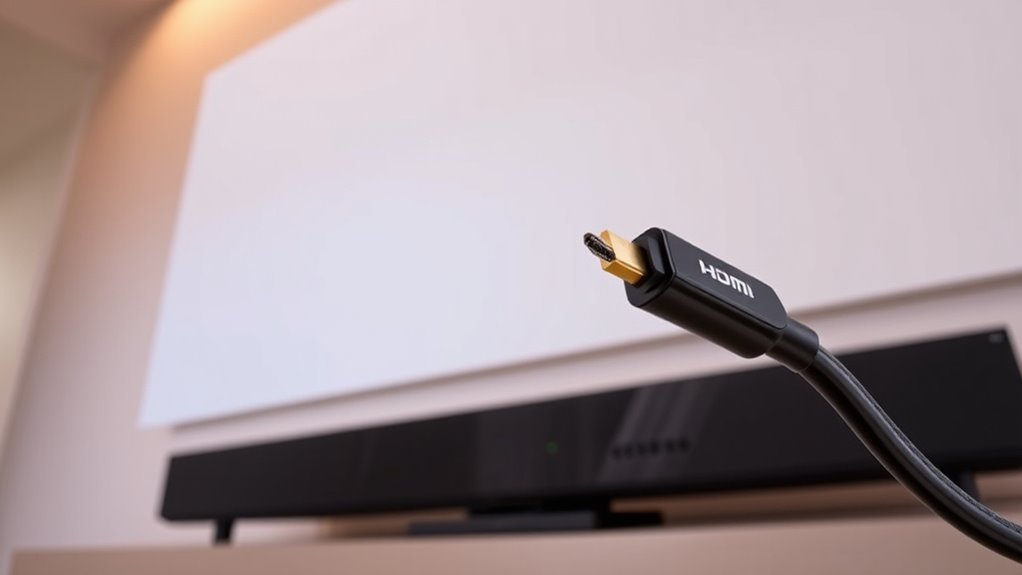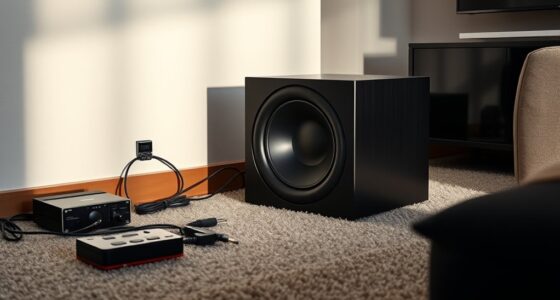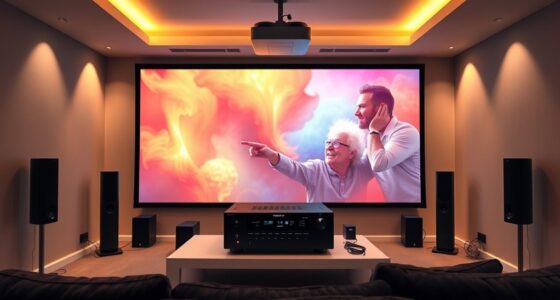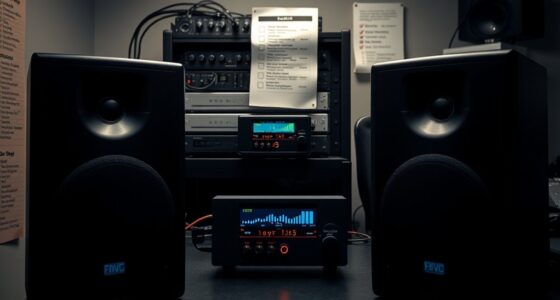HDMI ARC and eARC make it easy for you to send audio from your projector to your sound system using just one HDMI cable. With these features, your projector can send high-quality audio directly to your speakers or soundbar without needing extra cables. Make sure your devices support ARC or eARC and enable the right settings. Want to learn more about setup tips and compatibility? Keep exploring to improve your home theater experience.
Key Takeaways
- HDMI ARC and eARC enable audio to be sent from a projector to a sound system over a single cable.
- Ensure both your projector and sound system support ARC or eARC for proper audio transmission.
- Enable ARC or eARC settings in device menus to allow bidirectional audio flow.
- Use a high-quality HDMI cable rated for ARC or eARC to prevent audio dropouts.
- eARC supports higher-quality audio formats like Dolby Atmos, enhancing sound clarity from your projector.
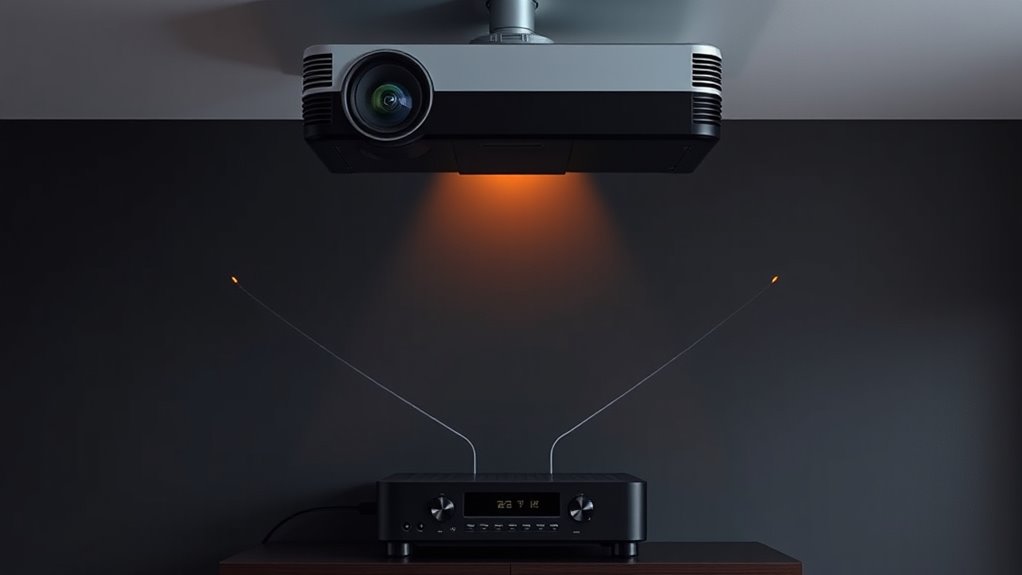
HDMI ARC (Audio Return Channel) and eARC (Enhanced Audio Return Channel) are technologies that simplify connecting your TV to sound systems and other audio devices. They allow audio to flow in both directions over a single HDMI cable, eliminating the need for multiple cables and making your setup cleaner and easier to manage. When you connect your projector to a sound system via HDMI ARC or eARC, you’re enabling your audio devices to communicate seamlessly, so sound from your projector can be sent directly to your speakers or soundbar without extra connections. This setup is especially useful when you’re watching movies or playing games, as it provides better audio quality and reduces clutter.
One of the key benefits of HDMI ARC and eARC is their ability to handle audio return. Instead of a separate audio cable from your TV or projector to your sound system, the audio signal can travel back through the same HDMI cable. This means you don’t need a dedicated audio output port or multiple cables, simplifying your setup and reducing cable clutter. However, for this to work smoothly, device compatibility is vital. Not all HDMI ports support ARC or eARC, so you need to ensure your projector, sound system, and any intermediary devices are compatible. Devices that support ARC can handle standard audio formats, but if you want the best possible sound quality, like Dolby Atmos or DTS:X, your equipment needs to support eARC, which provides higher bandwidth and compatibility with advanced audio formats.
Device compatibility plays a vital role in guaranteeing a smooth audio experience. When shopping for a projector or sound system, check whether they support HDMI ARC or eARC. If they do, you’ll enjoy an easier setup and better audio quality. Keep in mind that even if your devices support HDMI ARC or eARC, you might need to enable specific settings in the menu to activate this feature. Also, using high-quality HDMI cables rated for ARC or eARC can prevent issues like audio dropouts or loss of signal, especially with high-bandwidth formats. Additionally, understanding the dog names associated with different breeds can help you choose a name that reflects your pet’s personality and appearance, much like selecting the right audio connection enhances your home theater experience.
Frequently Asked Questions
Can I Connect Multiple Devices Using HDMI ARC and Earc Simultaneously?
You can’t connect multiple devices simultaneously using HDMI ARC or eARC because of multiple device compatibility and limited bandwidth. These ports are designed to link a single audio source with your sound system, so trying to connect multiple devices can lead to connection challenges or audio issues. To manage multiple devices, consider using an AV receiver or a switcher, which handles multiple inputs and guarantees seamless audio and video transfer.
What’s the Difference Between HDMI ARC and Earc in Audio Quality?
You’ll notice that eARC offers higher audio bandwidth than ARC, resulting in better sound quality. EARC supports uncompressed formats like Dolby Atmos and DTS:X, providing richer, more detailed audio. In contrast, ARC handles compressed audio, which may slightly reduce quality. Your signal compatibility depends on your device’s capabilities, but moving to eARC guarantees you’re getting the best possible sound experience with minimal compression and maximum clarity.
Do All Projectors Support HDMI ARC or Earc Features?
Your projector is not a mind-reader, so not all support HDMI ARC or eARC features. Many projectors lack this advanced audio transfer method, making compatibility a hit-or-miss situation. To guarantee seamless audio, check your projector’s specifications before buying. Look for HDMI ARC or eARC support in its input options, so you can effortlessly connect it to your sound system for theater-like sound quality without headaches.
How Do I Troubleshoot Audio Issues With HDMI ARC or Earc?
To troubleshoot audio issues with HDMI ARC or eARC, first check for audio delay and make certain your devices are compatible and updated. Disconnect and reconnect the HDMI cables firmly, and verify there’s no signal interference from other electronics. Adjust your audio settings on both the projector and sound system, and try switching to a different HDMI port if problems persist. These steps help resolve common issues like loss of sound or sync problems.
Is There a Difference in Cable Requirements for ARC Versus Earc?
Think of HDMI ARC and eARC as different roads leading to the same destination. For eARC, you need high-speed HDMI cables with the right cable specifications, like HDMI 2.1, to handle higher bandwidths. Compatibility considerations are essential; not all cables support eARC’s advanced features. So, make sure your cable matches the specs and is compatible with your devices to enjoy seamless, high-quality audio transmission.
Conclusion
Just like the symphony of the gods in ancient tales, your home theater can now deliver harmonious sound with HDMI ARC and eARC. By understanding these connections, you’re opening a door to a universe where your projector and sound system work together seamlessly—no more tangled wires or missed notes. Embrace the power of modern technology, and let your cinematic adventures echo with clarity and depth, transforming your space into a legendary theater worthy of mythic heroes.
